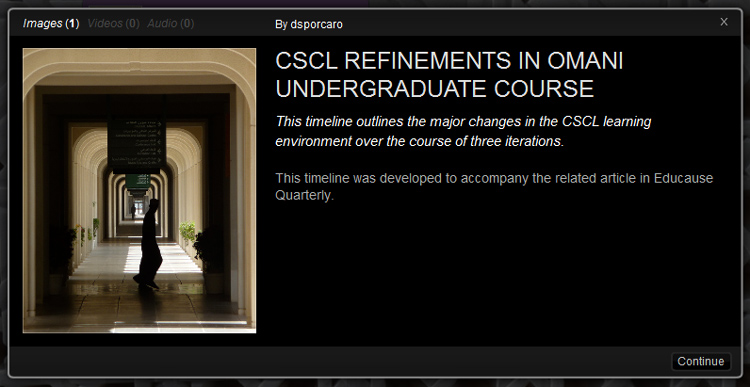Key Takeaways
- Traditional teaching methods in the Middle East have not prepared graduates for work in the 21st century.
- Computer-supported collaborative learning can increase students' opportunities to develop the skills and habits of mind needed to build knowledge societies.
- Outcomes include enhanced knowledge of course content, increased confidence in applying that knowledge and skills gained, stronger collaboration skills, greater ability to create rather than simply consume knowledge, and improved leadership and public presentation skills.
"Before I started taking this course I hated to work in groups because I thought that everybody will depend on the other to work and complete the project and there will be always disagreement between the members. However, working in different groups in this course all my ideas about collaborative learning have changed. I like it."
—Omani Undergraduate Student
Despite recent investments in and rapid modernization of university campuses in places like Kuwait1 and Saudi Arabia,2 higher education in the Middle East still faces many obstacles. One of the greatest has been a fundamental disconnect between education and employment, a possible factor contributing to many of the recent riots in the Arab World.3 In 2008 the World Bank published a report4 that highlighted the massive unemployment among college graduates across the Middle East and suggested that the traditional instructivist teaching methods long dominant there — which emphasize lecture, rote memorization, and high-stakes testing — have done little to prepare graduates for work in the 21st century. They suggested that in conjunction with other possible solutions, greater emphasis should be placed on constructivist methods, including student-centered learning and collaborative problem solving, coupled with a greater use of information and communications technology (ICT).
Others agree that to build knowledge societies, we need to improve students' abilities to think for themselves, weigh competing claims, argue their position with others, and work together to solve problems.5 One powerful way of increasing the opportunities for students to develop these skills and habits of mind in formal courses is computer-supported collaborative learning (CSCL). Well-constructed CSCL environments provide opportunities for students to develop the critical thinking skills they need after graduation, and to learn to create, rather than simply consume, knowledge.6 This article examines the effects of introducing CSCL into a Middle Eastern undergraduate course and the cultural, institutional, and societal factors to consider for sustainable design.
What Is Knowledge-Building CSCL?
"Computer-supported collaborative learning" can best be understood by analyzing the constituent elements of the term. "Computer-supported" means that computers are at the center of the learning environment, though this does not necessarily mean a traditional PC; mobile phones, GPS-enabled handheld devices, or computers have all been used to support CSCL.7 This support can either be through students working together in front of a computer with the computer acting as a tool to support face-to-face collaboration, or the students can work from a distance and use computers or other devices as mediation tools for communication, as places to organize their learning, or as authoring tools for building knowledge representations together (such as concept maps or essays). "Collaborative learning" means more than just dividing up an assignment and piecing it together at a later time, or what students often call "divide and conquer." Better termed "cooperative learning," it does have a place in higher education.8 For learning to be collaborative, however, students need to work with each other to solve problems. This means they need to recognize conflicting claims, weigh evidence, and argue their position with each other to negotiate meaning. In doing so, they co-labor, or work together, to solve problems, build products, or create knowledge.
A central point of CSCL is that students do more than simply acquire knowledge. Facts are not transmitted via a computer from one student to another, or from the teacher to the students. Rather students build knowledge, both within their own minds and as part of the collective human knowledge base, perhaps by sharing their newly created knowledge with others on the Internet.9 While this seems like a grand goal for an educational setting, it is expected of members of knowledge societies. Thus, to compete after graduation, students need to learn how to create solutions to local and global problems, discover and invent new products and processes, and contribute to the global conversation. While a lot for a student to handle individually, collaboration with others makes this knowledge building possible.10 Additionally, when collaboration via computers is "scripted,"11 or designed in creative and thoughtful ways that support collaboration, knowledge building becomes a natural part of learning. For instance, procedures that students should follow in negotiating meaning could be built into the computer-mediated communication tool the students use, thus prompting them on how best to formulate their responses in online discussions.
Many online tools can support collaboration. In many higher education courses today, for example, educators use Web 2.0 tools such as blogs, wikis, and social networking to support collaborative learning. Additionally, many popular learning management systems (LMSs) contain discussion forums and chat rooms that provide collaboration opportunities. As many educators have witnessed, however, simply placing two students together or creating an asynchronous discussion thread does not automatically lead to collaborative knowledge building. The learning environment — activities, tools, resources, and assessments — must be structured or scripted to provide the best possible support, especially for those not familiar with collaborative knowledge building, either by the teacher, through course activities, or via CSCL tools.
Several unique CSCL tools facilitate student knowledge building, including Knowledge Forum and Fle4 (Future learning environment 4). Fle4, which is a free plugin for WordPress blogs, guides students in their responses to blog posts. When students respond to other posts, they must select a knowledge type for their response (problem, my explanation, scientific explanation, evaluation of the process, summary, etc.). When they select a knowledge type, they receive suggestions for how to begin forming their response. The students' responses are labeled and colored according to the response types, as in Figure 1. The figure shows an example of Fle4 use in an Omani undergraduate course, with Edward de Bono's Six Thinking Hats method used to script the discussion. This scaffolding and tagging help the students reflect before simply responding "I agree" to another student's post. Because Fle4 utilizes a popular blog format, students learn how to use a tool they can continue to use outside their course activities.
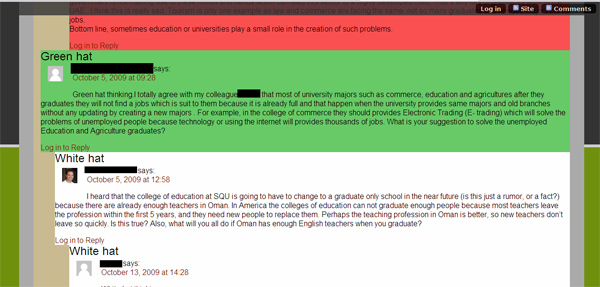
Figure 1. Example of Fle4 Use in an Omani Undergraduate Course
Fostering Communities of Learners
Designing a collaborative course is difficult and time consuming. Teachers and instructional designers can apply well-researched methods and learning frameworks as templates for designing their own collaborative learning environments. One design template, called "Fostering Communities of Learners" (FCL) and developed by Ann Brown and J. C. Campione12 for use in science classrooms, it has been applied in a variety of class types, including math, science, social studies, and English language arts.13 While its implementation varies from one classroom to the next, the basic principles are the same.
- The principles of activity, reflection, collaboration, and community14 were developed when students worked together on something they called a "consequential task." This could be a project that required students to solve problems and create solutions through product or idea.
- In order for every student to do their part, and to prevent one student from doing all the work while the rest hung on as "freeloaders," students were given "jigsaw" responsibilities, or pieces of the larger project that could be broken off and analyzed in more detail before returning to their place in the complete project.
- These jigsaws were roles or chunks of content the students had to research more deeply to become the expert on for their group. Jigsaw groups could be formed wherein students who shared the same role or subject could discuss their specialty and share their research.
- Then students returned to their original group to work on their consequential task, each jigsaw piece adding its expertise to the combined whole.
- Often, groups shared their learning with other groups in sessions Brown and Campione called "cross-talk." This gave students a chance to spread their ideas outside their group and learn more fully from each other. Cross-talk sessions were usually with students in other groups so that ideas could spread across the class.
Although this design is primarily used in K–12 education, it can also serve for higher education. For example, enabling students to work with experts or clients outside the classroom to accomplish authentic activities fits the FCL approach.15
Why CSCL in Oman?
Oman, along with many of its neighbors, has done much lately to improve education and build its own knowledge society. Facing dwindling oil resources, Oman's leaders look to build human capacity to diversify the country's economy. Oman has come far, considering its limited education foundation. Before the ascension of Sultan Qaboos in 1970, there were only three male-only primary schools in the country. Since then, Oman's educational structure has flourished. The first national university, Sultan Qaboos University (SQU), opened its doors in 1986 (see Figure 2). Since then, Oman has continued to invest in education, most recently beginning to shift teaching practices toward constructivist methods, such as child-centered and problem-based learning. Figure 3 shows the Omani Education System.
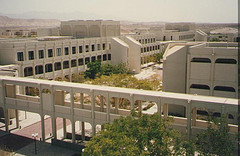
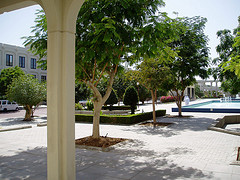

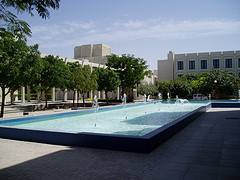
Figure 2. Sultan Qaboos University
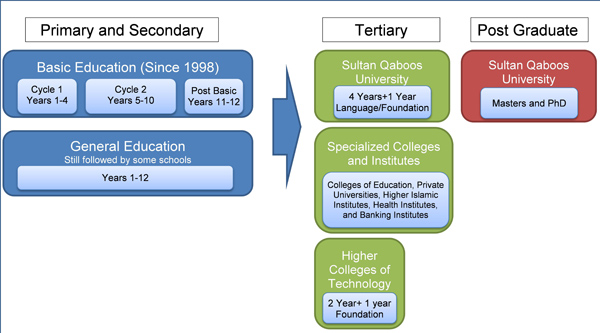
Figure 3. Overview of the Omani Education System
While many teachers have attempted to introduce cooperative projects or social technologies (such as discussion boards on LMSs), documented cases of CSCL applications in Oman are rare. Most higher education courses use traditional instructivist methods with relatively limited use of collaboration and discussion. Students are most often expected to acquire, rather than construct, knowledge and demonstrate acquired knowledge through high-stakes exams. Although courses at SQU have mixed-gender classrooms, social barriers between male and female students prevent them from talking or working with each other, or even sitting near one another. Thus discussion and idea sharing between genders in the classroom is often very limited. Many female students only feel comfortable discussing course topics in a computer-mediated environment with male students and vice versa, and if it were not for CSCL tools in the classroom, they would not talk with the opposite gender at all. It seems, then, that using CSCL tools and FCL methods would present a great opportunity for expanding the learning experiences of Omani university students.
Educational Design Research as a Tool for Design and Theory-Building
To develop a CSCL-based course and investigate the students' reaction to this innovation, we conducted an educational design research study at SQU in Muscat, Oman. Educational design research,16 also known as design-based research, has two goals:
- Build theory that informs our understanding about the nature of learning and teaching
- Create a learning environment (such as a course, a learning object, a game, etc.) that will remain sustainable within a local context
Often traditional academic research aims only for the first goal, while education design in practice aims for the second. To meet both goals, design research requires close collaboration between researchers and practitioners to understand the nature of the educational problem at the local level. Additionally, collaborators co-develop a prototype course to address the problem, followed by refinement of the course over multiple iterations.
In this case, the course was an introduction to educational technology for English-as-a-Foreign-Language (EFL) pre-service teachers (see Table 1 for the demographics). We worked together over three semesters (fall 2009, spring 2010, and fall 2010) to implement the course, collect data, and make refinements. The first two courses were taught by American David Porcaro, and the third by Omani Ali Al-Musawi, providing an opportunity for refinement of the course based on different teachers from different cultures. During the course, we used multiple methods to collect data about its implementation, as well as to understand how students in Oman adapt to educational innovation. The methods included:
- Conducting interviews of students and faculty
- Recording teachers' observations
- Collecting online data and assignments
- Having students complete questionnaires
Table 1. Background Demographics on Participating Students
| Demographics | 2nd–5th year undergraduates (mostly 4th or 5th year); nearly all SQU students take foundational courses the first year, including intensive English-language instruction |
| All Omanis | |
| All Arab/Moslem | |
| Nearly equal numbers of male and female | |
| Course Purpose | Preparing pre-service teachers to integrate technology in teaching |
| Only required educational technology course in the curriculum | |
| Several English-language sections reserved for EFL pre-service teachers | |
| Prerequisite Courses | Introduction to Instructional Objectives |
| Not required, but concurrent enrollment for many students in practicum teaching in Omani public schools | |
| Level of Computer Literacy | Introduction to Computers course taken by all students; many International Computer Driver's License holders |
| Some students have little to no exposure to computers before entering university |
A Course Designed: Iteration 1
The course followed the customary twice-per-week format of similar SQU courses, with the first day devoted to lecture and discussion on educational technology theory and the second day devoted to practical application. During the first half of the semester, students worked in small groups of their own choosing (four to five in a group) to develop various educational technology media, such as videos, presentations, and posters. During the second half of the semester, students formed separate self-selected groups, with four to five of the same or different students to build a multimedia kit consisting of digital and non-digital multimedia items that could be used in a unit of instruction in the schools. Since the curriculum in Oman is standardized nationally, the students only needed to choose a unit of lessons from the textbook for any grade, and then build or collect videos, websites, real objects, posters, transparencies, etc. for that unit. They had to choose a school in Oman where they would teach the unit and limit their media to things accessible in that type of classroom. For instance, if their classroom did not have a computer, projector, or Internet connectivity, then streaming videos could not be incorporated in class unless the school had a computer lab or learning resource center to which the teacher could take the students.
Within their consequential task groups, students chose one of five jigsaw roles to play in their project, each representing a member of a multimedia development team:
- Project manager
- Instructional designer
- Audio-video specialist
- Graphic designer
- Web specialist
As a way to build expertise in their role, each student researched some aspect of their role that they could apply in their project, and then wrote a small research paper on that subject. They were encouraged to discuss their developing expertise with others who shared the same role in other jigsaw groups. They then recombined with their project groups to design their multimedia kits. One day in the semester was set aside for "cross-talk"; due to limitations on male-female interaction in class, students rotated in either all-male or all-female groups to share their progress and ideas with students in the other groups. This allowed the students to share their progress and expertise with the students who did not share their role in their jigsaw groups or did not work with them in their project groups.
To facilitate knowledge building, the course used a wiki for all course-wide communication during the first semester (see Figure 4). Wiki pages as well as Fle4 discussion pages were created for each project group and jigsaw group. During the semester students participated in online discussions on course topics using Fle4 to familiarize them with the tools, and then were given discussion pages for their own group use. Students presented their projects in person to the entire class at the end of the semester.
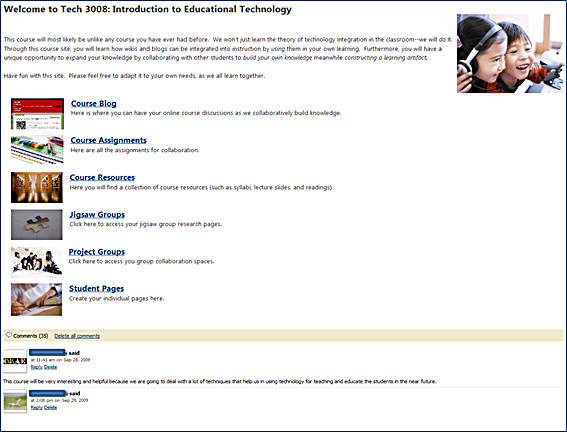
Figure 4. Screenshot of Wiki, with Student Comments on Front Page (First Semester)
As the semester concluded, many students found the collaborative interactions worthwhile, both in terms of enjoyment and in knowledge and skill development. While instances of collaborative knowledge building occurred among the most motivated students in the class, technical problems limited many students from participating fully. For instance, seven students (26 percent) did not leave a post on the blog during the course of semester, and 10 students (37 percent) responded less than once per post (see Figure 5). Most students reported collaborating either face-to-face or via SMS text messaging, and since many students were not accustomed to using the Internet, they found online discussions cumbersome. Very few students collaborated online in their jigsaw roles. Students reported limited off-campus access to the course websites, slow Internet connection speeds, and feeling uncomfortable doing class work on the Internet as reasons for low participation. This was partially due to limited bandwidth at the university and the fact that, due to the project's limit to on-campus access from the SQU servers, the server used for hosting Fle4 was located in Georgia, USA, thus slowing the blog's response time considerably.
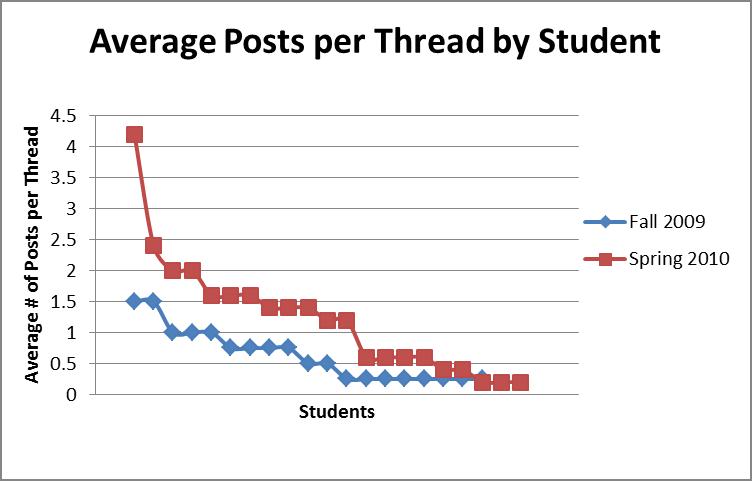
Figure 5. Average Number of Student Posts per Topic Thread
Due to the extremely limited computer skills of some of the students, many had difficulty keeping track of separate logins for the wiki and the Fle4 blogs, and they found the wiki too difficult to use. Students complained that they could not edit the wikis or create new pages, or they posted their responses on the wrong pages, accidentally deleted other students' entries, or used the wiki comments section rather than co-writing wiki pages. When students did use the course's Fle4 blog, most of them did not use the correct knowledge type for their discussion posts.
Often, the students and their American teacher did not have the same expectations for the course projects, especially the written paper about their jigsaw subject. Many students submitted verbatim copies of Wikipedia entries without proper citation, or segments of other websites that simply defined their jigsaw roles. Because Oman, like other Arab nations, is mainly an oral culture, students were unfamiliar with many aspects of information literacy, especially the concept of writing original reports. Additionally, although all formal face-to-face and online discussions in the course were in English as per university policy, students often discussed amongst themselves in Arabic; language proficiency limited the students' confidence in writing in English. Porcaro took all these factors into consideration in refining the course for the next iteration.
A Course Refined: Iteration 2
During the second semester (see Table 2), the course followed much of the first iteration's design, including forming consequential task groups to design a multimedia kit for a unit of instruction in their textbook. Jigsaw groups were formed, and students selected a jigsaw role for increased study. Students worked for the first half of the semester designing and developing instructional media, as before, and then formed their consequential task group in the second half of the semester. One session was devoted to cross-talk, as in the first semester.
Table 2. Number of Students per Semester
| Fall 2009 | Spring 2010 | Fall 2010 |
| 13 females | 9 females | 25 females |
| 14 males | 13 males | 16 males |
After reviewing the barriers to collaboration from the first semester, Porcaro made many technical refinements to the course and the CSCL tools. Because of the problems students had working with the course wiki during the first iteration, all course content and general discussion were enabled via the Moodle learning management system (see Figure 6). Students were more familiar with this tool, having used it in other classes. Also, because of students' difficulties in writing a research paper, during the second semester the students were asked to contribute to a wiki page for their jigsaw role. A less formal medium than submitting a research paper, this would allow students more opportunities to properly use wikis.
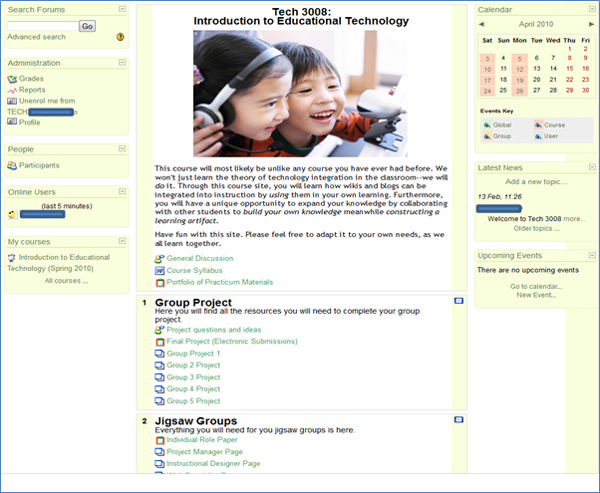
Figure 6. Screenshot from Moodle Course (Second Semester)
Because many students neglected to use the discussion forums or contribute to discussions during the first semester, during the second semester use of online discussions, wiki pages, and chat rooms was encouraged but not required. Although still asked to contribute to discussions on course topics throughout the semester, students were allowed more flexibility in how they used CSCL tools in their jigsaw and project groups.
The instructor also provided greater in-class support during the second semester:
- Giving more examples of successful past projects
- Talking with students individually to clarify their roles and help them determine appropriate topics of research
- Working with groups to make sure they understood expectations and were working well together
In the end, many more students participated in the course discussions during the second semester, and more collaborative knowledge building episodes occurred online. For instance, all 22 students participated in online discussions, many responding more often per thread (see Figure 5) and in a timelier manner than in the first semester (for instance, two to three weeks after a post for the second semester compared with as much as nine weeks after a post for the first semester). This frequently led to greater depth of discussion and better use of the CSCL tools by the students, since they returned frequently to the online discussions and responded to other students' posts. However, this online collaborative knowledge building occurred among only a few of the most motivated students; many of the other students seemed overwhelmed by the difficulty of using the course tools.
As Porcaro prepared to transfer the course to Al-Musawi, it was clear that most of the details of the course were too difficult to maintain. The least sustainable of the tools was the Fle4 blog. Additionally, both of us realized the course load was excessive for undergraduate students at SQU. As we prepared for the third iteration, we focused on which aspects of the course were essential to the theory of FCL and collaborative knowledge building, deciding that the scripting provided by Fle4 was too advanced for students with such limited technical experience.
A Course Transferred: Iteration 3
During the third semester, the course was taught entirely by Omani instructor Al-Musawi, who was not present during the first two semesters. This allowed us to see how the course would change when taught by an instructor from the local culture. Much of the maintenance and use of the site became too difficult to learn and adopt, especially given its limited use by students in previous courses. Thus the wikis and Fle4 blogs were dropped from the course, and all online collaborative discussion was conducted using Moodle discussion boards. The refinements of the third semester mainly focused on making the course as easy for another teacher to implement as possible, to provide for future scalability.
Overall, the course structure followed the same instructional design principles as the first two iterations. Student groups formed to design and produce three collaborative projects using units from Ministry of Education school textbooks. Members in each group researched their assigned roles and used their expertise to work with their group and solve learning problems. They also shared ideas with others in their role using the Moodle online forums. At the end of each project, each group had to present their projects to other groups. During this semester, students wrote reflections on their experiences and roles. The iteration placed greater emphasis on collaborative and student-centered methods, often focusing course instruction on these themes.
Design Considerations
- Build on the theoretical foundation of FCL: activity reflection, collaboration, and community
- Apply to practical courses or subjects; coordinate with practicum or internship courses as much as possible
- Use with senior students, or students proficient enough in the language of instruction to argue their position through online discussion
- Explain purposes and processes of collaboration thoroughly before beginning projects
- Allow ample early practice with CSCL tools before undertaking consequential task
- Provide in-class time to collaborate and limit expectations for out-of-class meeting and collaborating
- Place emphasis on performance or production assessment rather than traditional assessment
- Provide ample opportunities for students to share ideas in class as well as across genders online (cross-talks, jigsaw groups)
- Form groups early and provide preliminary small-scale projects to facilitate relationship building
Students reported their satisfaction and anticipation for applying CSCL in their teaching, noting "creative thinking, time management, and social interaction are the main skills we have developed throughout the projects." Additionally, the Al-Musawi felt that collaboration among students made them enthusiastic about their learning, especially when combined with online interaction and web-based resources. The simplification of online tools appeared to benefit the students, and many of the student project groups engaged in increased online discussions. However, a few students still did not engage in online discussions of collaborative knowledge building. At the end of the third iteration, the principles from the course, including FCL methodology and online collaborative knowledge building, appeared scalable to other classes. However, a greater emphasis on teacher-facilitated discussion (both online and face-to-face) was needed, as Fle4 was not a viable option for SQU courses in the short term.
The following timeline illustrates the major elements of the three iterations.
Impact of CSCL on Omani Higher Education
To understand the impact this course had in the Omani educational context, including students' growth in knowledge building and the scalability of the course, we analyzed the data to determine:
- How well the course was designed, or its legitimacy
- How well the course helped students build knowledge, or its efficiency
- How well the course would continue in the future, or its viability17
We focused on those themes that are most applicable in other higher education institutions in Oman or similar nations.
Legitimacy
As noted, building the course on sound theoretical principles strongly contributes to CSCL success. Through this course we tried to maintain the key principles of FCL (activity, reflection, collaboration, and community). The external panel of experts chosen to review the course all rated it high in its adherence to current scientific research and learning theory, and its coherence in design. Students reported that many of the key elements of FCL worked very well in the class, such as jigsaw, cross-talk, and online discussions. For instance, at the end of a cross-talk session many students expressed excitement and new ideas for their projects. One student who did not normally contribute to his group discussions came up to the instructor afterward and said, "This was good; let's do it again."
Design contributed only partly to the implementation's success, and much of how these principles were applied depended on the instructor. Instructor scaffolding, which played an important role in the course, would be hard to replicate in other courses taught by other instructors. For example, students commented that one instructor related to them as a peer and motivated them through enthusiastic encouragement, noting that this was not common in many of their courses at SQU. They felt free to express themselves in the class, and the instructor helped lessen their fears. As one student noted, the teacher was "very helpful with the students, and [he dealt] with them in a nice way, so I don't have any fears." Additionally, the way the teacher monitored group work, frequently talking with groups and discussing concerns with them, helped the students in their collaboration. This also included the instructor responding frequently to online discussions by asking questions and providing feedback throughout the learning process. One student summed up this idea by stating:
"The teacher most of the time, work as a facilitator of learning or a guide, maybe, of learning. And the way we used to, for example, get knowledge in the past, and the way we were learning in the past at schools was…different from how we learn today, because in the past we were…taking the information from the teacher himself and we were depending on the books but now we are…able to search for the information we need, and as a teacher, you...give us specific task to do, and we search for the information by ourselves."
It is important in implementing a course like this that the instructor spend a significant amount of time explaining the process of collaboration and the purpose of CSCL scripts, and helping the students practice the collaborative and technological skills that will be new for most of them. The first two implementations lacked this support and might have contributed to low use of the CSCL tools in the class. For most of the students, tools like blogs and wikis were new, and they needed to understand more clearly how to use them, or even why. Some students used Fle4 scripts correctly, but many would select the wrong knowledge type for their response or would continue to make inconsequential posts, such as "I agree with all of you." More time spent early in the class explaining the ideas and processes central to CSCL and more student practice with the tools would have helped.
Furthermore, designing group relationship building into the course was hard. For instance, while jigsaw groups were meant to limit the "freeloader" effect, several students in this course still did not contribute to their groups at all. Even with this unequal participation, the groups that fared the best had a strong leader who helped the group complete tasks on time and motivated others. In some groups this was the project manager, while in other groups this person had a different jigsaw role. For the instructor, this meant doing anything possible to support the group's leader or help a leader come to the front of the group to contribute to greater collaboration.
Additionally, encouraging students to form groups from preexisting relationships or building groups early in the course and developing them over the entire semester might have contributed to better collaboration. The groups with the best discussions and project outcomes consisted of students who had worked together before and were comfortable with each other. While often in postgraduate collaboration experiences people must work with others they don't know or with whom they have poor relationships, in a course where so much is new and unfamiliar, it may be worthwhile to support effective group relationships as much as possible, to allow students to succeed as they learn to collaborate.
Instructor Considerations
- Commit to collaborative knowledge-building principles
- Create peer-based relationships with students
- Motivate and generate enthusiasm for students
- Help students feel comfortable in expressing themselves freely
- Monitor group work in class; frequently cycle through groups and discuss group progress
- Provide students with individual advisement on their project roles
- Give feedback and support in online discussions
Efficiency
To judge the efficiency of the course, we looked at whether it yielded the results we targeted in our design.18 For us, that meant examining how the course appealed to students, what knowledge and skills they gained, and how they collaboratively built knowledge in the course.
Regarding appeal, most students enjoyed the course, and many noted that it was one of the best they had taken at SQU and a change from their other courses. Of the students surveyed, 84 percent of fall 2009, 79 percent of spring 2010, and 92 percent of fall 2010 students agreed or strongly agreed that they enjoyed the course assignments (see Figure 7). They especially enjoyed the practical rather than theoretical nature of the course. This was a common theme: Students felt the course was not only practical but also very relevant to their future careers. Some suggested that the collaborative work made the course enjoyable, while others mentioned they felt comfortable in the class and with the instructor. Not all students felt this way, however. Some considered the course workload excessive, especially compared with other courses at the university, and a few preferred working individually rather than collaboratively. However, even though this course entailed more work than others, many students found it useful and prepared them for their careers.
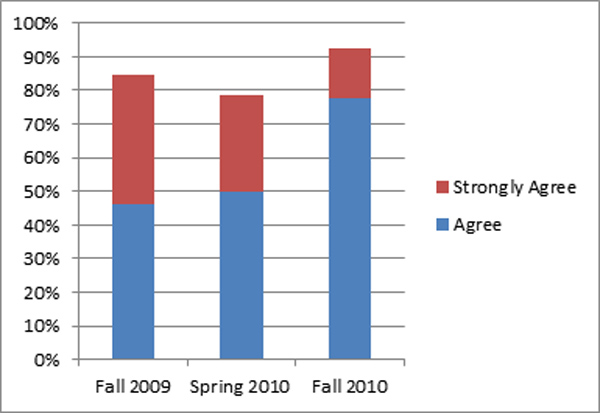
Figure 7. Percentage of Students Who Enjoyed Course Assignments (by Semester)
As for knowledge gained from the course, many students recalled specific technologies, ideas, or processes they learned in the course that they felt would be useful in their careers, such as specific graphic design principles or the ability to use movie editing software, among other skills. For many of the students, their confidence in using and applying technology grew throughout the semester. Several students also pointed to skills gained from group collaboration and their jigsaw roles, including leadership skills, instructional design concepts, time management, and publicly presenting opinions and ideas. For instance, when asked what she learned, one student said:
"I think I've learned how to present your personality. I mean, how to give others solution, how to solve the problems…and come up with the new ideas or… to be active in your group, not just to be passive and doing nothing. It helps you to improve your personality and your self-confidence."
With these many positive results, we were left wondering if the course met its main goal: Did the students build knowledge? While disappointed at many students' inability to use the online tools correctly, or even at all, upon further analysis we realized that many students did reach a point in their online discussions that demonstrated an ability to negotiate meaning through argument, present evidence from a variety of sources, make decisions, and offer innovative solutions to problems. A very few of the students did this online with the CSCL tools, such as the wiki and Fle4. Most of the students, however, did this in face-to-face collaboration, often as they learned or designed classroom projects together in front of a computer. Other times, students reported collaborating "under the radar," that is, by using e-mails, SMS texts, instant messaging, or other means not seen by the teacher. Quite often, collaboration was informal and initiated by the students, using means not intended by the instructor, such as questions posed by students on personal wiki pages or in the wiki's comments section.
Whatever the means, many students felt they benefited from their collaborative knowledge building. Several students suggested that having others in their group who could add input allowed them to successfully collaborate in designing their multimedia kits. One student explained how her group helped her fulfill her role as instructional designer to create an instructional game:
"Firstly I was stuck how to begin…to create these games and which way should I put these games in papers or on online. But because of useful friends, they help me to start. They said for me, now…you can write it, do it in online and [another group member] will scan for me pictures."
Others pointed to the online tools as a welcome way to share ideas across gender, especially because the male and female students rarely (if ever) interacted in the classroom. In this way, the best ideas and projects could benefit all students in the classroom, regardless of gender. In interviews at the end of the course, several students displayed an accurate understanding of what knowledge building meant and looked forward to applying it in their own classes. Some students even appeared to alter their understanding of teaching and learning, from instructivist to constructivist pedagogies. As one student noted:
"Before this course for me, I thought that teaching was only talking or writing on the board. Just like this. But when we came to this course, we have noticed that it's more beneficial for us. And teaching is not talking or not writing. But is group working and using technology, makes this teaching or education more interactive and interesting."
Lastly, over the semester some students began to display a shifting epistemology, from objectivist knowledge acquisition to constructivist knowledge creation, as observed in classroom behavior and revealed by their evolving perspectives in ongoing interviews. This epistemological shift is an important step for students adopting constructivist methods in their own teaching and learning, though this course could only prompt a small change in their epistemological development.
Viability
In judging the viability of the course, we wanted to know if it was practical, relevant, and sustainable for use in other courses at SQU. In terms of practicality, several obstacles stood in the way of collaborative discussion. For instance, the institutional preference for course assessment based mainly on midterm and final exams limited the acceptance of performance or project assessment. Though the university does provide for flexibility in assessment, if other courses were to adopt this structure, the teachers, students, and administrators would need to clearly understand and be comfortable with the alternative assessments required for this type of course.
Additionally, the separation of male and female students greatly limited the kinds of in-class discussions possible. Online tools lessened this problem to some extent. However, since many students chose not to participate in online discussions, their ideas were rarely, if ever, heard by students of the opposite gender. Additionally, students found it difficult to arrange proper meeting times and places for out-of-class collaboration. Because many of the female students lived on campus, they were able to meet together in the evenings. However, some male and female students lived at home (as far as an hour by school bus, which left the campus only one time daily), and most male students lived four to six kilometers away in off-campus housing. Additionally, students were not used to meeting at other students' houses to study or work on projects, and many students complained of not being able to find an appropriate place or time to collaborate on their projects.
While online collaboration might provide an answer to some of these problems, there were several further technical constraints. Problems often arose with Internet speeds or connections. Usually, as mentioned above, the bandwidth was much too low to provide a user-friendly online experience for students, so many did not participate in the online collaboration. The few students who did have off-campus access to the Internet often could not access the course site for various reasons. For those who relied on the campus computers, the few labs on campus were often being used for other classes. Additional problems included labs with malfunctioning or virus-laden computers, limited software, restricted hours of operation (often only until 6:30 or 7 p.m.), and inadequate numbers of support staff (who left around 4 p.m.). Some students had extremely limited technical ability, since many had never really used a computer before entering college. Tasks like logging in to a website and making comments on a blog were extremely difficult for them. If these technical considerations had been understood before the course design, perhaps the course would have focused more on face-to-face collaboration and relied on one CSCL tool for online collaboration, such as Moodle discussion threads. In this way students could become proficient in its operation, and then other tools, such as wikis or Fle4 blogs could be added afterward.
Technical Considerations
- Provide online space for mixed-gender idea sharing
- Allow students to maintain anonymity or choose a pseudonym
- Provide spaces for groups to discuss their work privately
- Use easy-to-use or widely-used CSCL tools where possible (LMS discussion boards, for example, and to a lesser extent blogs and wikis)
- Plan for low bandwidth or limited online access; be flexible in when or how students use the tools
- Ensure computer labs are available after hours for out-of-class collaboration; ensure labs are staffed during operating hours with knowledgeable support personnel
- Provide technical support for CSCL design and maintenance (knowledgeable staff who can create and maintain a WordPress.org blog on the university's server)
Although practical constraints posed many problems, several students expressed the desire to work through these difficulties due to the relevancy the course held in their own careers and lives. Because the project involved creating media for current Ministry of Education textbooks, students concurrently engaged in their teaching practice found many opportunities to try out their ideas in the classroom. Several students immediately applied ideas from the course to their student teaching. Others brought ideas from their practicum classrooms to their group projects. Many of the students who enjoyed the course the most and did the best were those who directly applied new knowledge in their practice teaching, suggesting that courses like this should be aligned with other internship or practical experience courses. However, even though all the students were education majors, many did not plan on working in education but rather hoped to find jobs in the private sector or the military. Finding relevancy for these students was less apparent, since much of the course revolved around designing and implementing instructional media. Nevertheless, many of these students recognized the applicability of skills learned in the course — such as working with others, managing projects, and using technology — to their own careers.
The real test of this course is its sustainability over time. Much of the course's success depends upon the teacher, as noted. For other teachers to apply CSCL tools such as Fle4 and collaborative knowledge-building methods such as FCL, they must have sufficient buy-in, available preparation time, technical skill, and knowledge about collaborative knowledge building. If this type of course were to be adopted in other classrooms, however, many teachers would not have the time to adequately prepare and maintain the tools, or the incentive to change their well-established teaching methods — which are much easier to implement, much less time-intensive, and provide the same rewards to the teacher. Additionally, to scale a course like this to multiple classes would put serious pressure on the limited hardware and network resources of the department computer labs and their staff. Finally, in a university where the language of instruction for most courses is English but many students have limited proficiency, relying heavily on online discussion and writing may decrease the students' success in the classroom, especially for those not studying to be English teachers.
All these problems aside, we see hope for the viability of these CSCL ideas in Omani higher education. Several students succeeded in the course despite technical or pedagogical limitations, and several applied or planned to apply knowledge building in their own classes, where these ideas will continue to spread. Several teachers at SQU are committed to collaborative knowledge building and already have used elements of CSCL and FCL in their classes. The course continued to be viable when transferred to a new instructor, showing that the course design holds potential for scalability. Thus it appears that the principles of collaborative knowledge building and CSCL can be applied and adapted in similar universities in the region.
Lessons Learned
While this case study focused on a single course at a single university in Oman, several lessons can be shared across the region. Based on our attempt to link higher education to workforce skills through CSCL, we can begin to understand what steps should be taken in similar projects at other universities in the Middle East. The main points are summarized at different spots throughout this article (Design Considerations, Teacher Considerations, and Technical Considerations).
As these types of courses find a place at other institutions in the Middle East, these design principles will continue to be refined. But an important element of this or other designs is self-reflection and strong collaboration with local practitioners to uncover any hidden assumptions in the design or implementation. Although the cross-cultural elements of this study are the topic of another manuscript, the main lesson from this part of the design research study, demonstrated through this case study, was that the outcomes of applying CSCL environments in the university context outweigh the barriers to adoption. These outcomes include:
- Enhanced course content knowledge
- Increased confidence in applying course knowledge and skills
- Stronger collaboration skills (arguing ideas, making decisions, providing solutions)
- Greater ability to create instead of simply consume knowledge
- Added benefits of leadership and presentation skills
In this way, students in the Middle East can better prepare for the careers of the future and for collaboratively creating solutions to many of the region's most pressing problems.
- Sean Dollman, "A Model of American Higher Education in the Middle East," EDUCAUSE Quarterly, vol. 30, no. 3 (2007).
- Eltayeb Salih Abuelyaman, "Making a Smart Campus in Saudi Arabia," EDUCAUSE Quarterly, vol. 31, no. 2 (2008).
- Mohammad Al-Momani, "The Arab Youth Quake: Implications on Democratization and Stability," Middle East Law and Governance, vol. 3, no. 1–2 (2011), pp. 159–170.
- The World Bank, Mena Development Report, The Road Not Traveled: Education Reform in the Middle East and Africa (Washington, DC: The World Bank, 2008).
- UNESCO, Towards Knowledge Societies (Paris: United Nations Educational Scientific and Cultural Organisation Publishing, 2005).
- Carl Bereiter, Education and Mind in the Knowledge Age (Mahwah, NJ: Lawrence Erlbaum Associates, 2002).
- For instance, see some of the mobile CSCL projects of the Computer-Supported Collaboration and Learning Lab at Pennsylvania State University.
- Robert E. Slavin, "Cooperative Learning," Review of Educational Research, vol. 50, no. 2 (Summer 1980), pp. 315-342.
- Marlene Scardamalia and Carl Bereiter, "Computer Support for Knowledge-building Communities," Journal of the Learning Sciences, vol. 3, no. 3 (July 1993), p. 265.
- Tammy Schellens and Martin Valcke, "Fostering Knowledge Construction in University Students through Asynchronous Discussion Groups," Computers & Education, vol. 46, no. 4 (May 2006), pp. 349–370.
- Pierre Dillenbourg and Fabrice Hong, "The Mechanics of CSCL Macro Scripts," International Journal of Computer-Supported Collaborative Learning, vol. 3, no. 1 (March 10, 2008), pp. 5–23.
- Ann L. Brown and J. C. Campione, "Psychological Theory and the Design of Innovative Learning Environments: On Procedures, Principles, and Systems," in Innovations in Learning: New Environments for Education, ed. Leona Schauble and Glaser (Mahwah, NJ: Lawrence Erlbaum Associates., 1996), 289-325.
- An entire issue (March 2004, Vol 36, no 2) of the Journal of Curriculum Studies was dedicated to Fostering a Community of Learners. It featured reports on its application in 4 different classrooms, as well as commentary and responses to these studies.
- Miriam Gamoran Sherin, Edith Prentice Mendez, and David A. Louis, "A Discipline Apart: The Challenges of 'Fostering a Community of Learners' in a Mathematics Classroom," Journal of Curriculum Studies, vol. 36, no. 2 (March 2004), pp. 207–232.
- Younghee Woo, Jan Herrington, Shirley Agostinho, and Thomas C. Reeves, "Implementing Authentic Tasks in Web-Based Learning Environments," EDUCAUSE Quarterly, vol. 30, no. 3 (2007).
- Jan van den Akker, Koeno Gravemeijer, Susan McKenney, and Nienke Nieveen, Eds., Educational Design Research (New York and London: Routledge, 2006).
- These criteria are based on Susan McKenney, Nienke Nieveen, and Jan van den Akker, "Design Research from a Curriculum Perspective," in Educational Design Research, Jan van den Akker, Koeno Gravemeijer, Susan McKenney, and Nienke Nieveen, Eds. (New York and London: Routledge, 2006).
- Ibid., p. 80.
© 2011 David S. Porcaro and Ali S. Al-Musawi. The text of this EQ article is licensed under the Creative Commons Attribution-Noncommercial-No Derivative Works 3.0 license.

